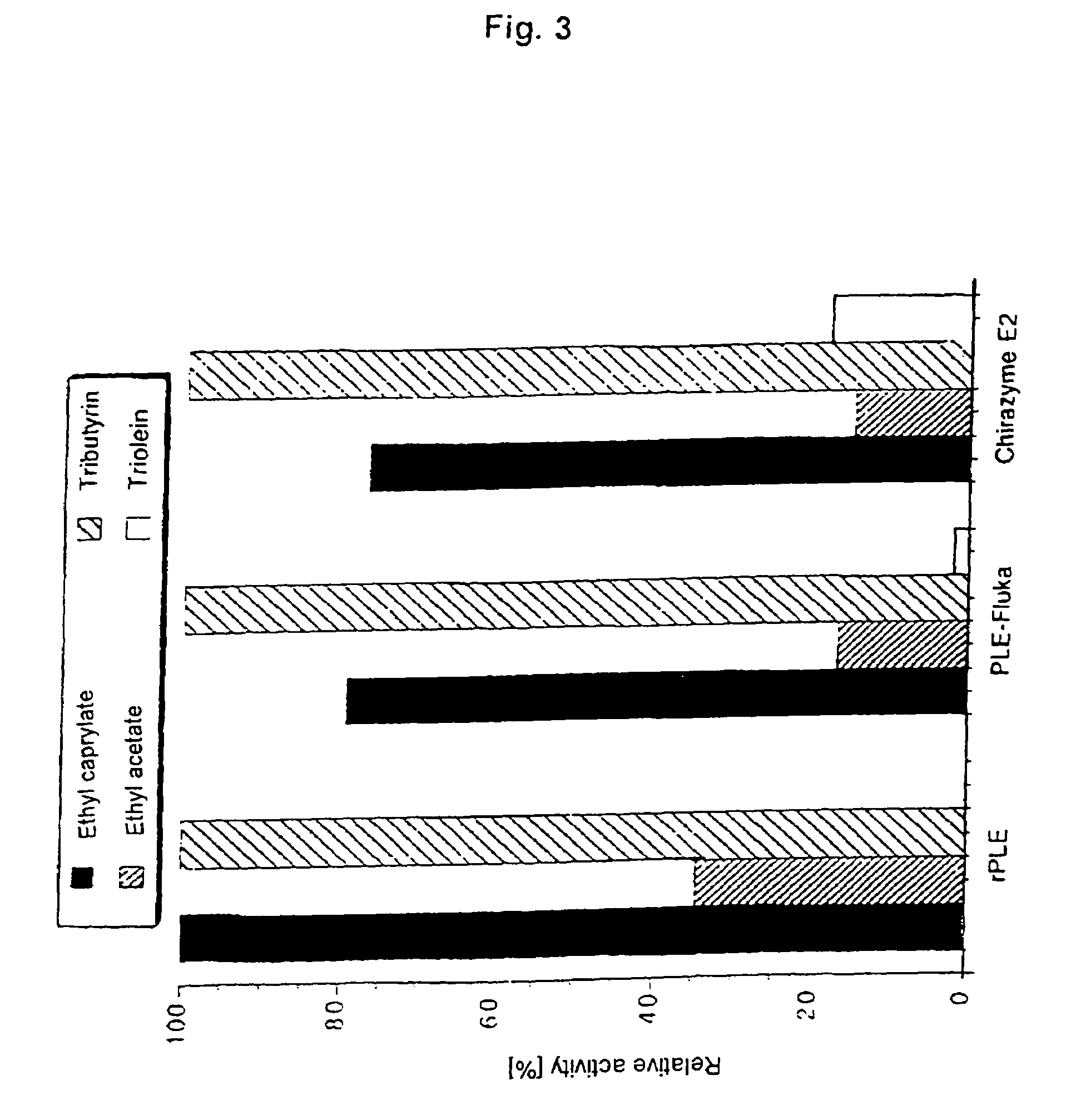Recombinant porcine liver esterases, their use and a method for the production thereof
a technology of esterases and porcine livers, applied in the field of enzymically active porcine liver esterases, can solve the problems of few esterases available for use in racemate resolution or asymmetrisation, and achieve the effect of simple manner
- Summary
- Abstract
- Description
- Claims
- Application Information
AI Technical Summary
Benefits of technology
Problems solved by technology
Method used
Image
Examples
example 1
Tissue Preparation, mRNA Isolation, and Cloning of cDNA
[0051]0.8 g of fresh pig liver tissue is homogenized and the polyA-mRNA released is isolated using the Fast Track 2.0 kit (Invitrogen) according to the manufacturer's instructions. cDNA was synthesized from the mRNA extract by RT-PCR with the aid of the cDNA Cycle™ kit (Invitrogen) according to the kit's protocol, using oligo-dT primers. The RT-PCR products were then used as templates for amplification of porcine liver esterase (PLE). The gene-specific primers used were oligonucleotides PLE-1F (Seq. Id. No. 2) and PLE-2R (Seq. Id. No. 3) (Table 1), which at the same time introduced restriction cleavage sites required for cloning the PCR product. Both primers were prepared on the basis of the sequence of the mRNA of porcine liver proline-α-naphtylamidase (Matsushima, M., et. al. (1991) FEBS Lett. 293, 37–41) which was assumed to have a sequence complementary to PLE. The PCR was carried out in a thermocycler (Robocycle Gradient 40...
example 2
Construction of an Expression Vector for E. coli and P. pastoris:
[0053]For intracellular expression of the cloned PLE in E. coli, the vector pUC19-PLE-R was cut with NdeI and EcoRI, resulting in a 1705 bp fragment coding for the complete naturally occurring PLE sequence. The restriction fragment obtained is inserted into the NdeI / EcoRI restriction cleavage site of pT1-BTL2 (Belev, T. N. et. al. (1991) Plasmid, 26,147–150), forming a new vector, pCYTEX-PLE (6652 bp).
[0054]For periplasmic expression of PLE sequences without the N-terminal leader sequence (mPLE), the corresponding DNA sequence was amplified using primers PLE-3F (Seq. Id. No. 4) and PLE-4R (Seq. Id. No. 5) (table 1) and ligated via its blunt end into the pT1-ompA sequence of the vector pT1-ompA-BTL2 (Rua, M. L., et. al. Appl. Microbiol. Biotechnol. 49, 405–410) which can likewise be amplified with the aid of primers PLE-5F (Seq. Id. No. 6) and PLE-6R (Seq. Id. No. 7) (table 1). The resulting vector (which no longer con...
example 3
Expression of Recombinant PLE in E. coli DH5α
[0058]Recombinant E. coli DH5α clones which have been transformed with vector pCYTEX-PLE or pCYTEX-ompA-mPLE are cultured in LB medium at 37° C., 200 rpm to a cell density of OD578 0.8 to 1.0. Expression of the recombinant protein was induced by increasing the temperature to 42° C. Every hour, a sample was removed, and the cells were harvested 3 to 4 hours after induction and stored at −20° C. or analyzed directly by means of SDS-PAGE or an activity assay.
PUM
| Property | Measurement | Unit |
|---|---|---|
| Temperature | aaaaa | aaaaa |
| Fraction | aaaaa | aaaaa |
| Molar density | aaaaa | aaaaa |
Abstract
Description
Claims
Application Information
 Login to View More
Login to View More - R&D
- Intellectual Property
- Life Sciences
- Materials
- Tech Scout
- Unparalleled Data Quality
- Higher Quality Content
- 60% Fewer Hallucinations
Browse by: Latest US Patents, China's latest patents, Technical Efficacy Thesaurus, Application Domain, Technology Topic, Popular Technical Reports.
© 2025 PatSnap. All rights reserved.Legal|Privacy policy|Modern Slavery Act Transparency Statement|Sitemap|About US| Contact US: help@patsnap.com



